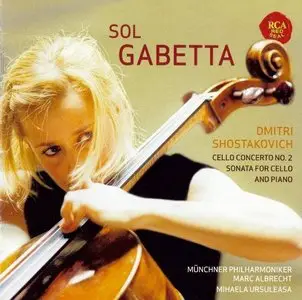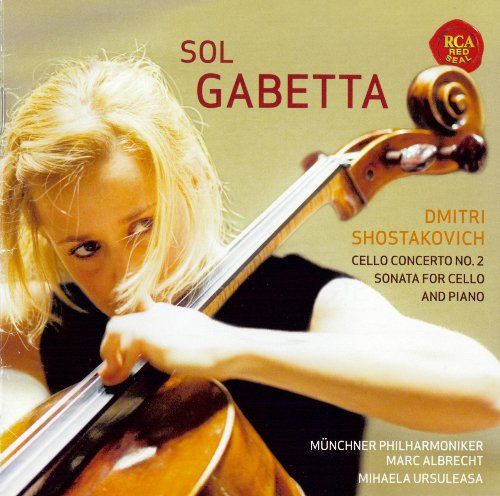Shostakovich: Concerto And Sonata For Cello - Sol Gabetta (2009)
EAC Rip | Flac (Image + cue + log) | 1 CD | Full Scans | 283 MB
Genre: Classical | Label: Rca Victor Red Seal | Catalog Number: 735961
EAC Rip | Flac (Image + cue + log) | 1 CD | Full Scans | 283 MB
Genre: Classical | Label: Rca Victor Red Seal | Catalog Number: 735961
The Second Concerto can seem an oddly diffuse work in lesser hands and it is to Sol Gabetta's credit that she offers a distinctive, introspective approach, daringly spacious at times, deliberately eschewing superficial excitement.
Composer: Dmitri Shostakovich
Performer: Mihaela Ursuleasa, Sol Gabetta
Conductor: Marc Albrecht
Orchestra/Ensemble: Munich Philharmonic Orchestra
Reviews: Sol Gabetta is a cellist in great demand as a concert performer. If the high-end German record shops such as Ludwig Beck, Munich and Dussmann, Berlin are anything to go by Gabetta is being strongly marketed by her record label. The programme chosen this time for the young Argentine cellist is all-Shostakovich with wonderful accounts of both the Concerto and the Sonata. The Concerto recording was made at live concerts in January 2008 in the admirable acoustic of the Philharmonie at Munich’s Gasteig. The applause has been elided. On the other hand the Sonata in which Gabetta teams up with Romanian-born pianist Mihaela Ursuleasa is a studio recording made in Zurich. My disc was sent from Germany with German-only text.
The Cello Concerto No.2, written in the last decade of his life, was dedicated to Rostropovich who premièred the score at Shostakovich’s 60th birthday concert in Moscow. Compared to the first Cello Concerto, Op. 107 from 1959 this relatively underrated score is only now beginning to establish its rightful place in the repertoire. The harsh constraints of living and working under the Soviet regime must surely have helped shape its character.
In the opening Largo the cello plays virtually continuously. Right from the first bars the darkly brooding intensity of the cello is spine-tingling. Gabetta’s rich mocha-toned instrument is caught splendidly by the sound engineers. Taking the listener by surprise the cannon salvos and pounding martial beat at 3:58-4:03 is highly dramatic. From 4:31 the anguished wails of the cello are remarkably affecting. A reflective passage on the cello at 5:34 and 6:55 is developed by the orchestra into a thickly textured and deeply depressing episode. A concentrated section from 7:28 feels almost overwhelming. Coming as a welcome relief from 8:35 is a more upbeat passage. It is not long before the playful figures become restless and demanding and the overwhelming weight of torment returns. At 10:32-10:59 the percussion blows are quite ferocious and serve as an ominous warning. The pounding continues but fades and disappears into the distance. Over a rumbling and restless orchestra the cello from 12:54 with its plaintive theme tries to calm the agitation.
Serving as a Scherzo the central movement marked Allegretto is terse and highly rhythmic. A waltz-like street theme on the cello with a sardonic twist opens the movement. Horn-calls punctuate the scene together with a colourful array of percussive effects. Gabetta’s energetic playing cuts through the macabre orchestral writing seemingly intent on holding the cello back. Played continuously, the closing movement also an Allegretto, is heralded by a horn fanfare and drum-roll. Gabetta plays a languorous melody of a certain nobility that has been described as “ barcarolle-like”. Especially interesting are the unusual orchestral textures with notable percussive effects. From 4:41 the tempi shift quickly several times and take on a curious galloping quality. At 6:35 the cello theme becomes one of sadness and tender introspection - a mood that underpins the remainder of the movement. Percussion lashes against a frenetic cello line from 9:41 create a disconcerting effect and this builds to a terrifying climax at 10:52. The breathless cello writing then recovers its poise to repeat the melancholic but introspectively steely theme. If that was possible the mood becomes even more mournful with Gabetta’s cello sounding as if it was weeping. Snare drums and other light percussion effects close the score. The orchestra provide warm and positive support .
For alternative versions of the Cello Concerto No.2 I have long been satisfied with that from cellist Heinrich Schiff with the Bavarian Radio Symphony Orchestra under Maxim Shostakovich. With playing of impressive assurance the performance was recorded in 1984 at the Hercules Hall, Residenz, Munich on Philips 475 7575. (c/w Shostakovich Cello Concerto No. 1). Another beautifully played account is from cellist Mischa Maisky with the London Symphony Orchestra under Michael Tilson Thomas. It was recorded in 1993 at the Abbey Road Studios in London on Deutsche Grammophon 445 821-2. (c/w Shostakovich Cello Concerto No. 1).
The four movement Cello Sonata was written when Shostakovich still had artistic freedom. This was prior to the denunciation in 1936 by the Soviet authorities and before his fall from favour owing to the opera Lady Macbeth of the Mtsensk District. Essentially a lyrical score rather than experimental the Sonata was premièred in 1934 in Moscow by cellist Viktor Kubatsky, its dedicatee. Interestingly there have been several arrangements for viola and piano.
The two main themes of the opening movement could not be more different in character. The first is an upright elegant melody that Gabetta and Ursuleasa. It is intensified in tension and made more weighty until it becomes unruly bordering on stormy. By contrast the second theme is cloaked in lush yearning Romanticism. Gabetta’s glorious tone is outstanding and Ursuleasa revels in the long warm lines. An Allegro the second movement is a countryside romp that Gabetta and Ursuleasa develop into the manner of an excitable folk dance. Sombre and mournful in the third movement Largo Gabetta’s cello sounds as if it is sobbing. The intensity becomes heavier with the cello reaching down to its deepest register. In the skittish and scampering Rondo: Finale the piano has abundant opportunity to shine with Ursuleasa demonstrating her assurance in a number of dazzling runs. It is Gabetta’s relatively restrained cello part that keeps the merriment in check.
For both the splendid playing as well being an important music document I admire the version of the Sonata played by cellist Daniil Shafran and the composer on piano. Recorded in 1956 I have the performance on Revelation RV10017. (c/w Rachmaninov Cello Sonata). I also play often the account from cellist Leonid Gorokhov and pianist Nikolai Demidenko. This satisfying version was recorded at Champs Hill, Pulborough, Sussex in 2004 on ASV Gold GLD4006.
I was perfectly happy with this RCA Victor Red Seal recording in both the concerto and sonata. Gabetta’s cello is placed well forward and is vividly clear. I know of no more dramatic and beautifully played account of the Concerto.
Tracklisting:
1. Sonata for Cello and Piano in D minor, Op. 40 by Dmitri Shostakovich
Performer: Mihaela Ursuleasa (Piano), Sol Gabetta (Cello)
Period: 20th Century
Written: 1934; USSR
2. Concerto for Cello no 2 in G major, Op. 126 by Dmitri Shostakovich
Performer: Sol Gabetta (Cello)
Conductor: Marc Albrecht
Orchestra/Ensemble: Munich Philharmonic Orchestra
Period: 20th Century
Written: 1966; USSR
Exact Audio Copy V1.0 beta 3 from 29. August 2011
EAC extraction logfile from 4. December 2013, 8:36
Sol Gabetta / Shostakovich - Cello Concerto No.2; Cello Sonata
Used drive : HL-DT-STDVDRAM GSA-4083N Adapter: 1 ID: 0
Read mode : Secure
Utilize accurate stream : Yes
Defeat audio cache : Yes
Make use of C2 pointers : No
Read offset correction : 667
Overread into Lead-In and Lead-Out : No
Fill up missing offset samples with silence : Yes
Delete leading and trailing silent blocks : No
Null samples used in CRC calculations : Yes
Used interface : Native Win32 interface for Win NT & 2000
Used output format : User Defined Encoder
Selected bitrate : 896 kBit/s
Quality : High
Add ID3 tag : No
Command line compressor : C:\Program Files\Exact Audio Copy\Flac\flac.exe
Additional command line options : -V -8 %source%
TOC of the extracted CD
Track | Start | Length | Start sector | End sector
––––––––––––––––––––––––––––-
1 | 0:00.00 | 15:46.41 | 0 | 70990
2 | 15:46.41 | 4:31.07 | 70991 | 91322
3 | 20:17.48 | 17:11.21 | 91323 | 168668
4 | 37:28.69 | 12:06.58 | 168669 | 223176
5 | 49:35.52 | 3:06.00 | 223177 | 237126
6 | 52:41.52 | 9:15.06 | 237127 | 278757
7 | 61:56.58 | 4:06.68 | 278758 | 297275
Range status and errors
Selected range
Filename J:\New Music\Shostakovich - Cello Concerto No.2; Cello Sonata (Sol Gabetta)\Shostakovich - Cello Concerto No.2; Cello Sonata.wav
Peak level 100.0 %
Extraction speed 2.8 X
Range quality 100.0 %
Test CRC D886C954
Copy CRC D886C954
Copy OK
No errors occurred
AccurateRip summary
Track 1 accurately ripped (confidence 6) [7BA81D01] (AR v2)
Track 2 accurately ripped (confidence 6) [20CCE29C] (AR v2)
Track 3 accurately ripped (confidence 6) [FBF01D1D] (AR v2)
Track 4 accurately ripped (confidence 6) [4CEE109A] (AR v2)
Track 5 accurately ripped (confidence 6) [523962AB] (AR v2)
Track 6 accurately ripped (confidence 6) [D0DDBA81] (AR v2)
Track 7 accurately ripped (confidence 6) [45DB240F] (AR v2)
All tracks accurately ripped
End of status report
==== Log checksum 0CF9C431EB7613BB90A01A64569FEDD01070EE2463ADFDA40BCEC7D5FF9D599B ====
EAC extraction logfile from 4. December 2013, 8:36
Sol Gabetta / Shostakovich - Cello Concerto No.2; Cello Sonata
Used drive : HL-DT-STDVDRAM GSA-4083N Adapter: 1 ID: 0
Read mode : Secure
Utilize accurate stream : Yes
Defeat audio cache : Yes
Make use of C2 pointers : No
Read offset correction : 667
Overread into Lead-In and Lead-Out : No
Fill up missing offset samples with silence : Yes
Delete leading and trailing silent blocks : No
Null samples used in CRC calculations : Yes
Used interface : Native Win32 interface for Win NT & 2000
Used output format : User Defined Encoder
Selected bitrate : 896 kBit/s
Quality : High
Add ID3 tag : No
Command line compressor : C:\Program Files\Exact Audio Copy\Flac\flac.exe
Additional command line options : -V -8 %source%
TOC of the extracted CD
Track | Start | Length | Start sector | End sector
––––––––––––––––––––––––––––-
1 | 0:00.00 | 15:46.41 | 0 | 70990
2 | 15:46.41 | 4:31.07 | 70991 | 91322
3 | 20:17.48 | 17:11.21 | 91323 | 168668
4 | 37:28.69 | 12:06.58 | 168669 | 223176
5 | 49:35.52 | 3:06.00 | 223177 | 237126
6 | 52:41.52 | 9:15.06 | 237127 | 278757
7 | 61:56.58 | 4:06.68 | 278758 | 297275
Range status and errors
Selected range
Filename J:\New Music\Shostakovich - Cello Concerto No.2; Cello Sonata (Sol Gabetta)\Shostakovich - Cello Concerto No.2; Cello Sonata.wav
Peak level 100.0 %
Extraction speed 2.8 X
Range quality 100.0 %
Test CRC D886C954
Copy CRC D886C954
Copy OK
No errors occurred
AccurateRip summary
Track 1 accurately ripped (confidence 6) [7BA81D01] (AR v2)
Track 2 accurately ripped (confidence 6) [20CCE29C] (AR v2)
Track 3 accurately ripped (confidence 6) [FBF01D1D] (AR v2)
Track 4 accurately ripped (confidence 6) [4CEE109A] (AR v2)
Track 5 accurately ripped (confidence 6) [523962AB] (AR v2)
Track 6 accurately ripped (confidence 6) [D0DDBA81] (AR v2)
Track 7 accurately ripped (confidence 6) [45DB240F] (AR v2)
All tracks accurately ripped
End of status report
==== Log checksum 0CF9C431EB7613BB90A01A64569FEDD01070EE2463ADFDA40BCEC7D5FF9D599B ====
Thanks to the original releaser



